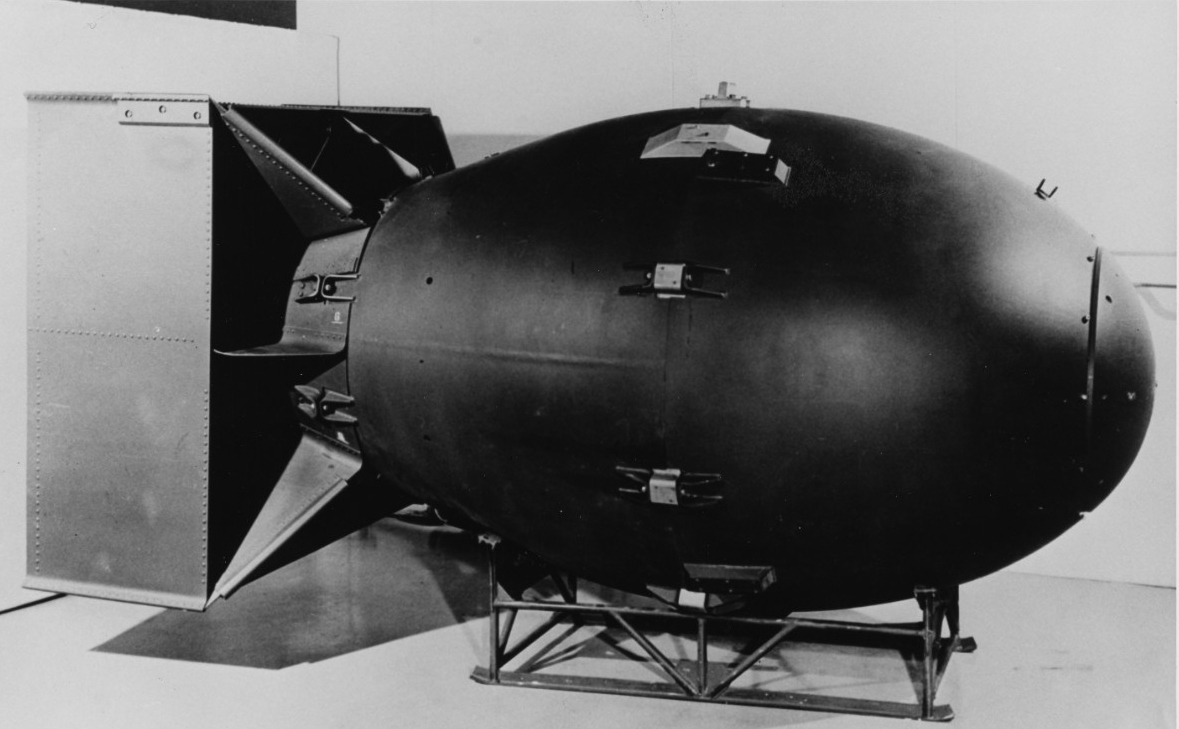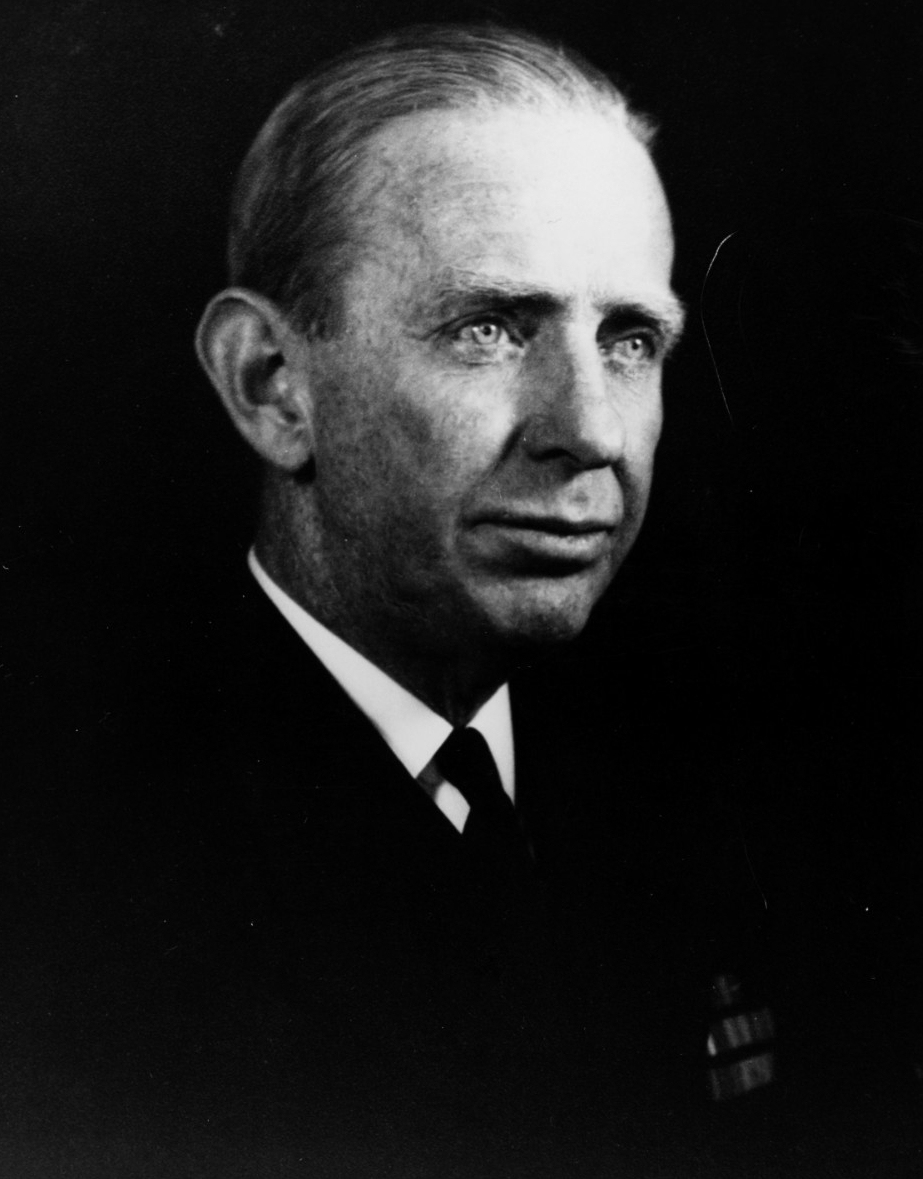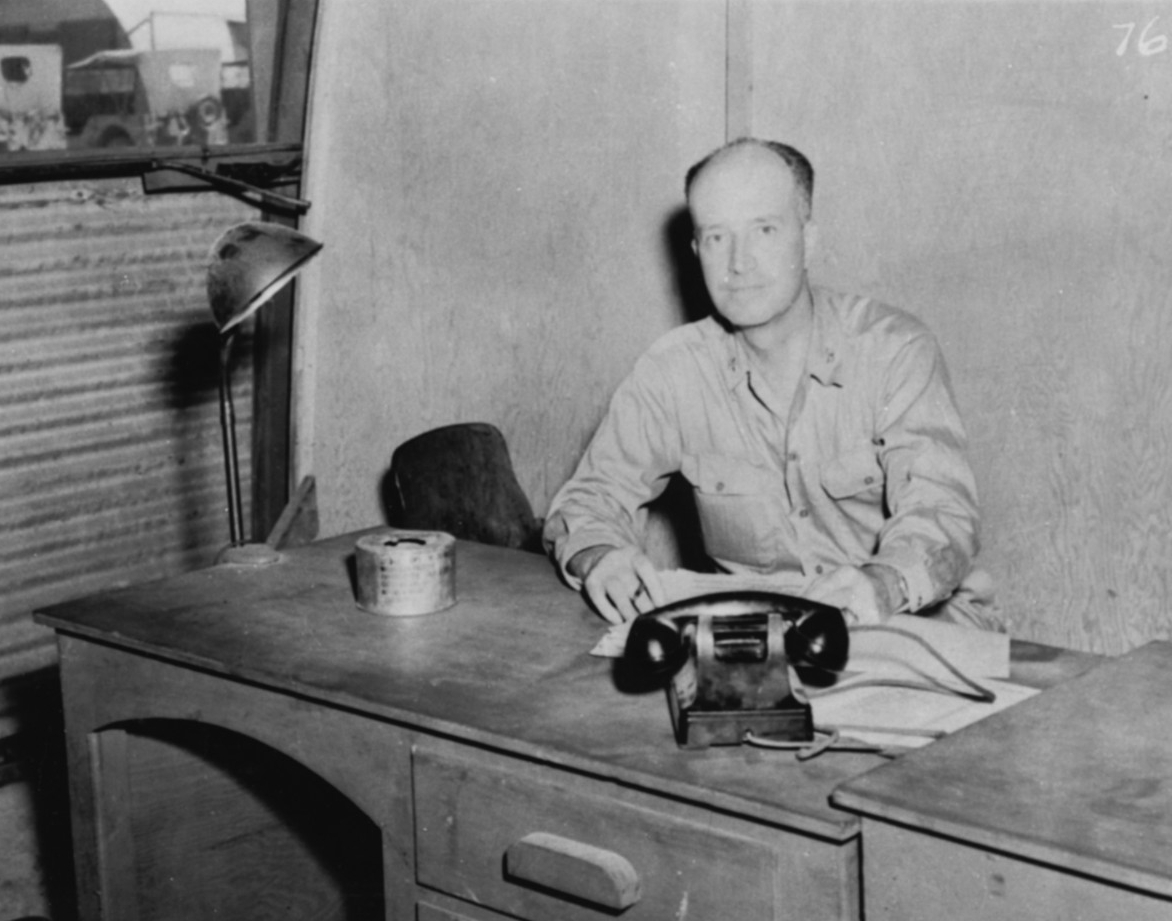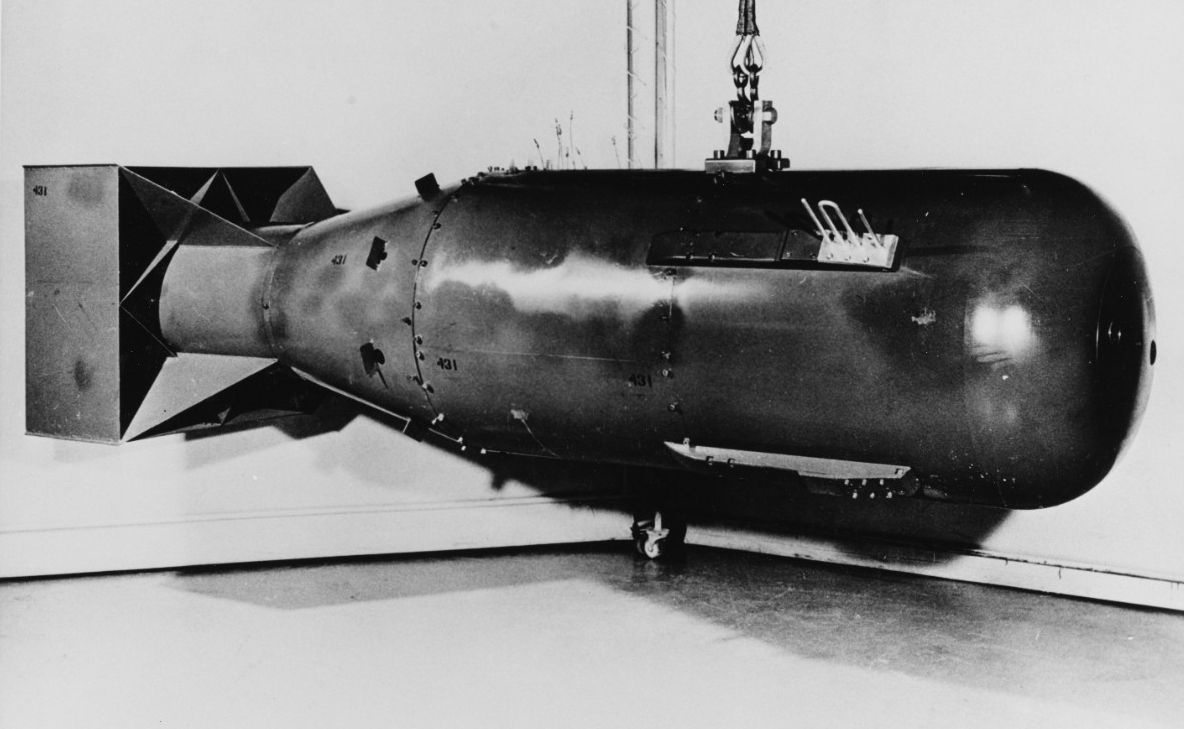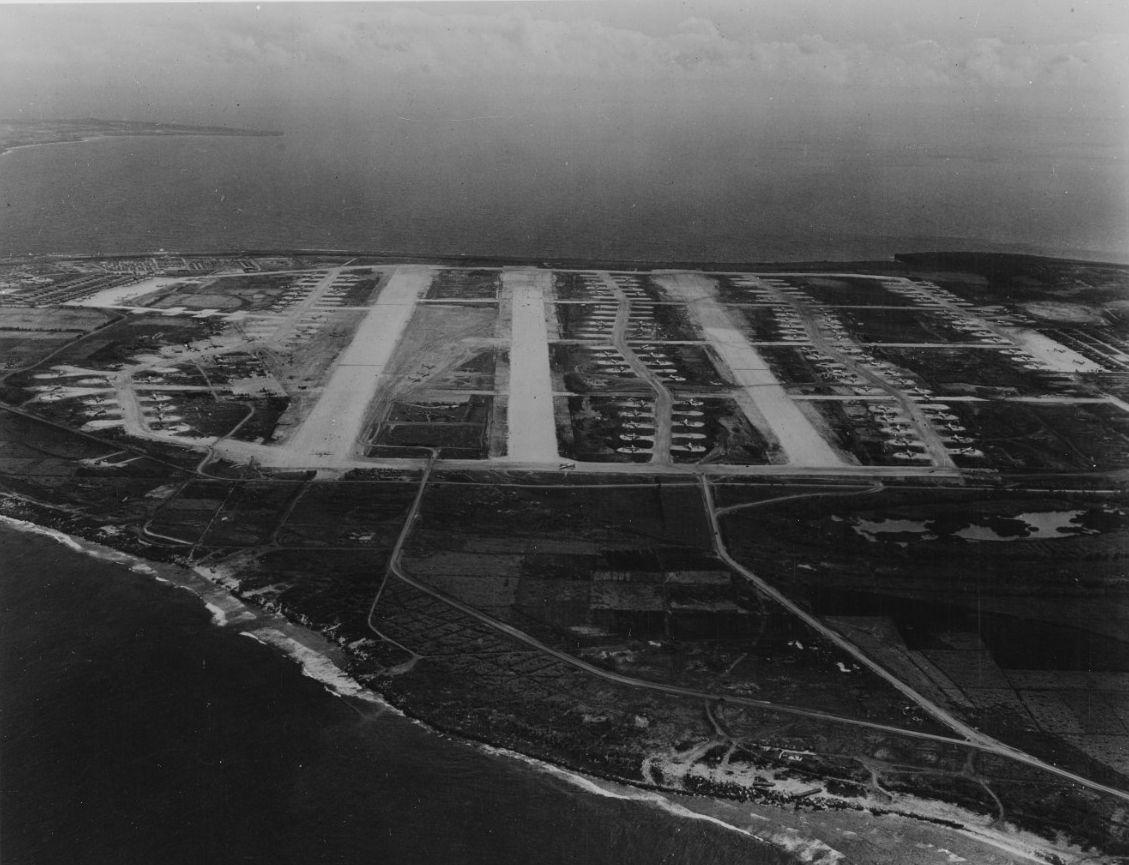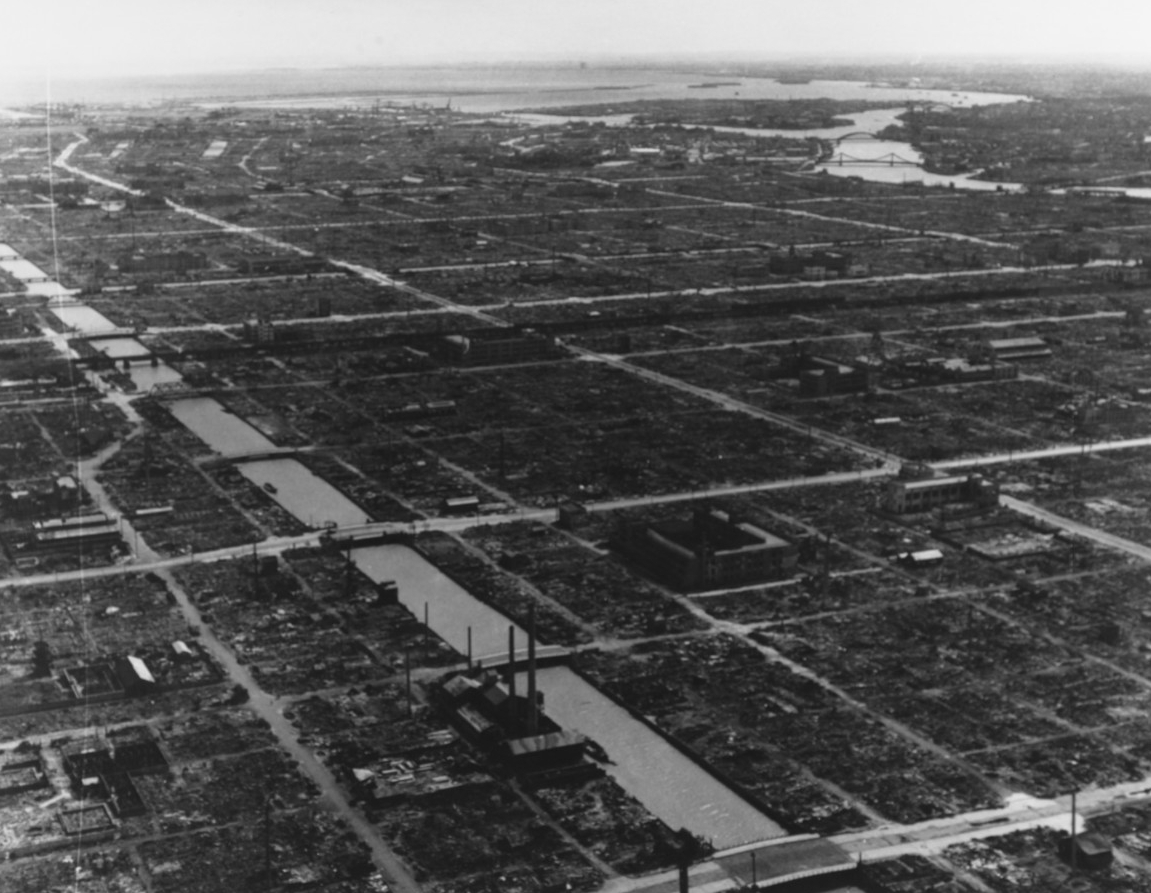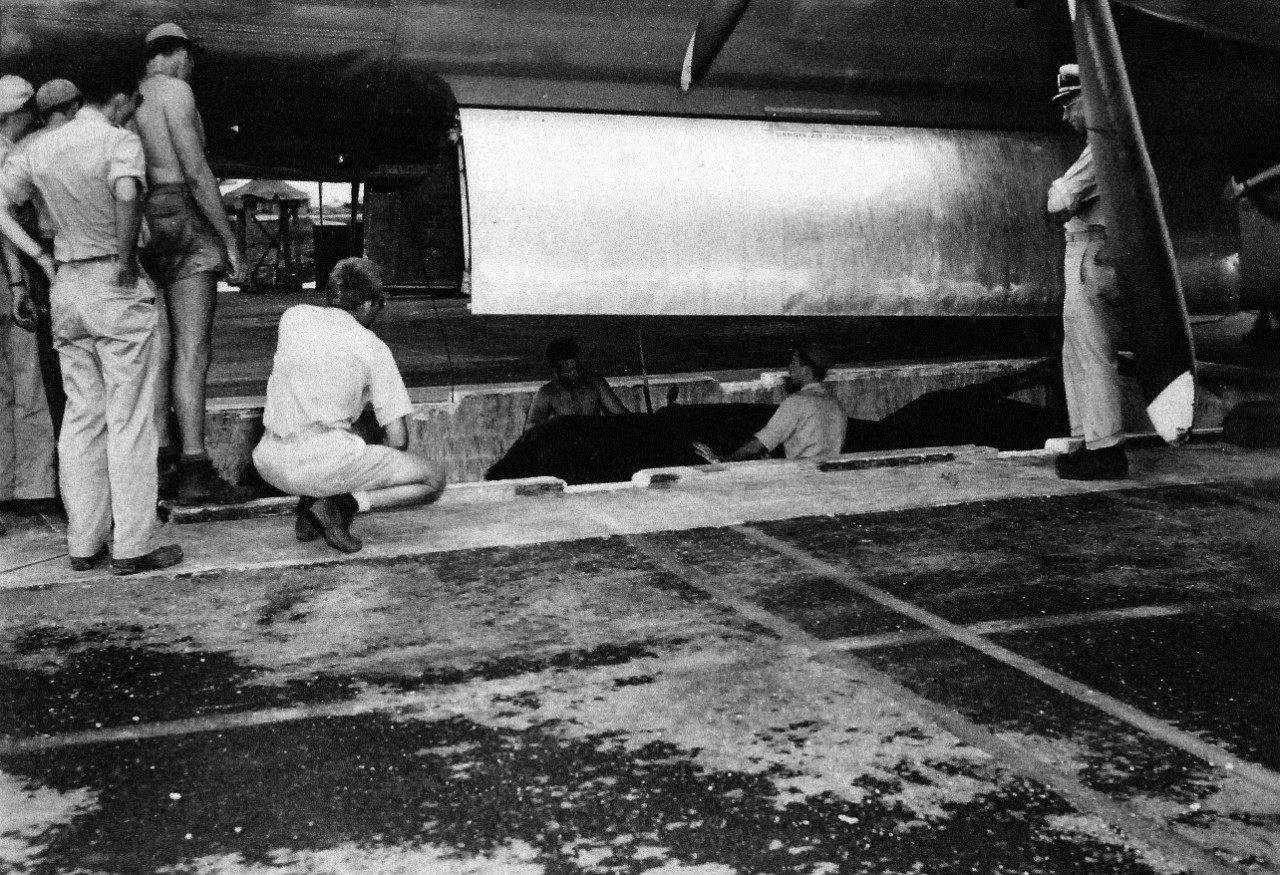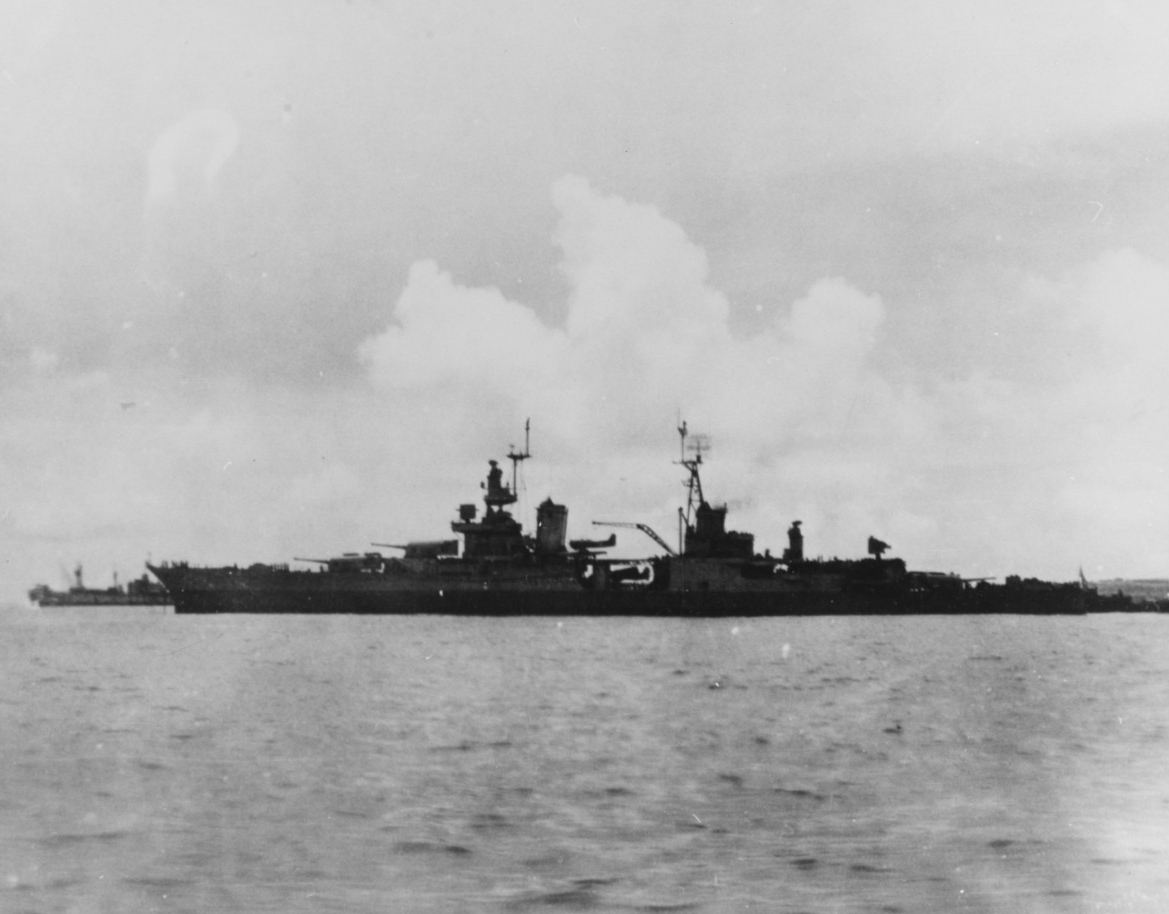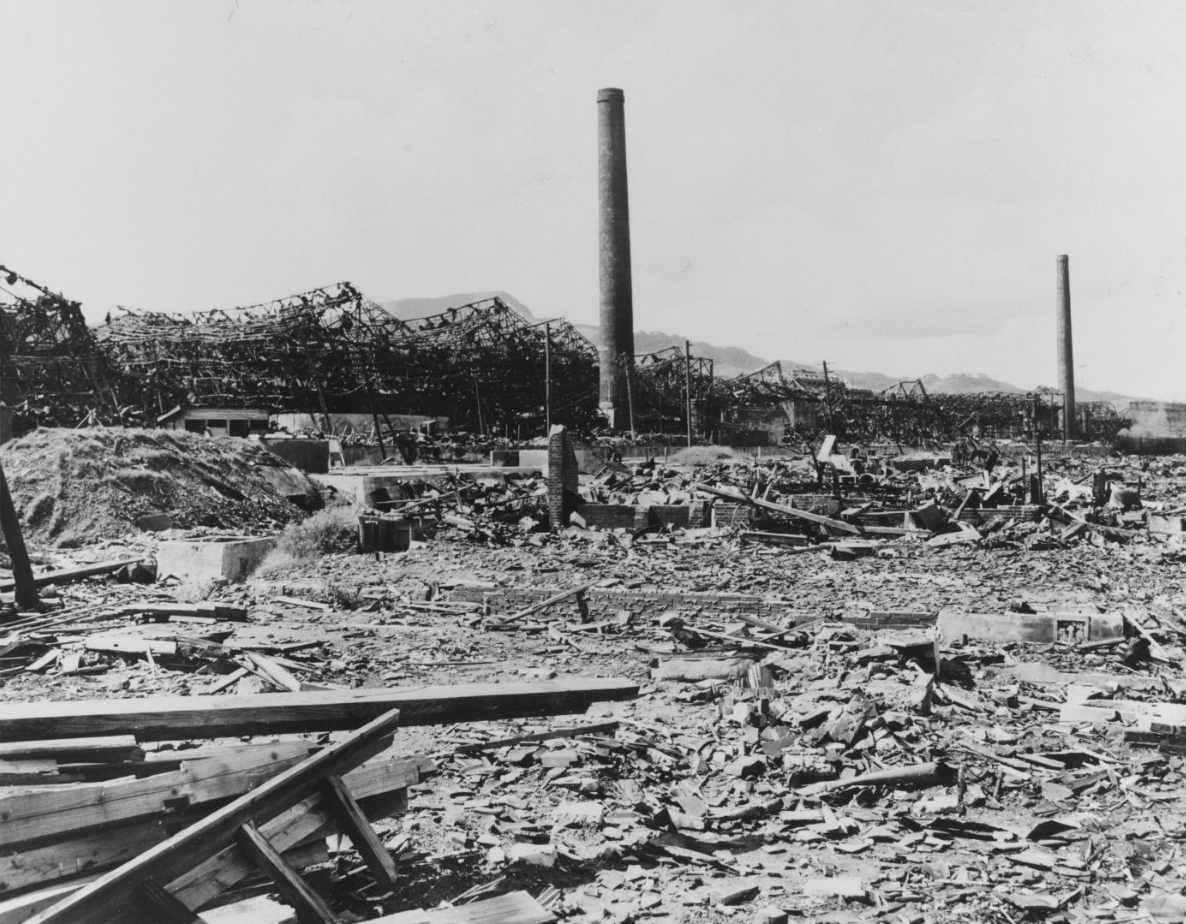H-052-1: The U.S. Navy's Role in the Development and Employment of the Atomic Bomb, 1939–45
This H-gram is not intended to be a comprehensive history of the Manhattan Project, nor is this H-gram trying to diminish the critical roles of the U.S. Army, the Army Air Force, or the civilian scientists and engineers. Instead, this H-gram shows that U.S. Navy personnel performed some of the most vital roles in the operation. Finally, this H-gram is not intended to be a discussion of the morality of using atomic weapons, other than to note that from a safe remove, it is easy for armchair generals and historians to judge the decisions made by senior political and military leaders when every option was incredibly bad.
The B-29 firebombing raids that began in March 1945 killed more Japanese civilians than the atomic bombs (as many as 100,000 civilians in the first firebombing raid on Tokyo alone on 9–10 March 1945). An invasion of Japan would have cost far more lives—U.S. and Japanese, military and civilian—than the atomic bombs. Those who claim otherwise need to study up on Saipan, Iwo Jima, and Okinawa. Blockading and starving 100 million Japanese was hardly a more “humane” option and not likely to convince the Japanese military diehards to give up. Only Emperor Hirohito had the moral authority to convince the Japanese military to surrender, and it was the atomic bombs that convinced him.
An obvious U.S. Navy contribution is that without the U.S. Navy, there would have been no B-29 bomber bases in the Marianas Islands in range of Japan. An earlier attempt to bomb Japan with B-29s flying from bases in China (Operation Matterhorn) had been a costly failure, reaching only targets in the far south of Japan at a high cost in B-29 aircraft (128, mostly due to operational causes), and that was before the massive Japanese Ichigo offensive in China in late 1944 rolled up the bomber airfields. Trying to conduct operations from the Aleutians was a non-starter, and the Soviet Union would not agree to enter the war against Japan until after the defeat of Nazi Germany. The Marianas Islands were the fastest and only really viable option to bring Japan within range of U.S. strategic bombers.
The Beginning of the U.S. Navy Atomic Research Program, 1939
In December 1938, German chemists Otto Hahn and Fritz Strassmann discovered that a collision of a neutron with a uranium nucleus had the unexpected result of producing barium as a byproduct. Physicists Lise Meitner and her nephew Otto Frisch (both Austrian-born Jews who had recently fled from Berlin to Stockholm and Copenhagen, respectively) analyzed the results and determined that the uranium atom had split in two, and they estimated the significant energy released, which Meitner and Frisch reported in a paper in January 1939 that explained the physics of the process, coining the term “fission.” Due to the anti-Semitic environment in Nazi Germany, Hahn and Strassman published their results without acknowledging Meitner and Frisch’s contribution. (Meitner would never really get due credit for her key role.) Frisch reported the findings to his boss, eminent Danish physicist Niels Bohr, who in turn shared it with American physicists. Physicists around the world quickly grasped the revolutionary implications of this discovery, particularly the enormous energy that would be released in a chain reaction of splitting atoms. They also recognized the dire danger of this process in the hands of Nazi Germany.
On 17 March 1939, Italian-born physicist Enrico Fermi (who had fled from Mussolini’s Fascist Italy to the United States in 1938 for the safety of his Jewish wife) gave a briefing in Washington, D.C., (attended by some U.S. Navy personnel) in which he described the implications of the discovery of fission. The technical director of the Naval Research Laboratory (NRL), civilian physicist Ross Gunn, attended the brief and understood the significance both for atomic weapons and power. He also immediately grasped the potential of atomic power for submarine propulsion. Gunn convinced his boss, Captain Hollis M. Cooley (the director of NRL), to request funding for additional research in atomic energy from the head of the Bureau of Engineering, Rear Admiral Harold G. Bowen, who agreed to commit $1,500 to the study of atomic power on 20 March 1939. Thus the Navy atomic energy effort preceded the inception of the Army’s study (which would become the Manhattan Project) by seven months, although the Navy’s study was focused on submarine propulsion and not weapons. Ross Gunn would also conceptualize the use of an atomic-powered submarine as a platform for launching missiles.
Niels Bohr had theorized that only the isotope Uranium-235 was fissile (i.e., capable of sustaining a nuclear fission chain reaction). NRL set to work in trying to find ways to separate relatively rare U-235 from the more common U-238. There were several ways to do this, none of them easy. NRL then contracted with several universities to study the four main techniques. The thermal diffusion technique was not initially considered to be the most promising, but Ross Gunn was impressed by the work of young physicist Philip H. Abelson (who was a co-discoverer of the synthetic element Neptunium in 1940) in that process and recruited him to work for NRL as a Navy employee in June 1941. Abelson invented the “liquid thermal diffusion isotope separation technique” at a facility at the Philadelphia Navy Yard. The Navy also built a pilot plant at Anacostia.
As the Manhattan Project (atomic weapons), which started in October 1941, got off the ground in 1942, led by Army Major General Leslie Groves of the Corps of Engineers, it quickly dwarfed the NRL effort and essentially “cornered the market” on uranium around the globe. (The Manhattan Project placed stringent security requirements on all aspects of nuclear research, which actually had the adverse effect of slowing the Navy effort related to nuclear propulsion.)
The Manhattan Project did not initially pursue the thermal diffusion technique, although the Navy continued to work on it, albeit at a disadvantage, as the Manhattan Project sucked up all available resources. However, Manhattan Project efforts with other techniques also met with major challenges and setbacks, and in June 1944, the Manhattan Project decided to also pursue the Navy’s thermal diffusion technique and built the S-50 thermal diffusion plant at Oak Ridge, Tennessee, where it produced slightly enriched uranium as an initial step toward producing weapons-grade uranium via the gaseous and electromagnetic methods, which shaved time off the long and tedious process. The thermal process would ultimately be given credit for shortening the war by eight days (this was a reflection of how scarce weapons-grade uranium was when the first atomic bomb was used).
Ross Gunn would be awarded a Navy Distinguished Civilian Award by Secretary of the Navy James V. Forrestal at the end of the war and would then immediately resume work on submarine nuclear propulsion. In November 1945, Abelson wrote the first report describing how a nuclear reactor could be installed on a submarine to provide both electrical power and propulsion.
Key Navy Personnel Involved in the Manhattan Project
A key figure in the U.S. Navy’s contribution to the atomic bomb was Rear Admiral William Reynolds Purnell (USNA ’08). Purnell had commanded four different destroyers in World War I and been awarded a Navy Cross in command of Lamson (DD-18). At the start of World War II, he had just been promoted to rear admiral and was the chief of staff for the Asiatic Fleet, where he experienced the searing debacle of the utter collapse of the Allied defense of Southeast Asia and the Dutch East Indies. He then became the Deputy Chief of Naval Operations for Materiel, working directly for CNO Admiral Ernest K. King.
Purnell was the Navy representative on the Joint Committee on New Weapons and Equipment. In September 1942, he became the Navy representative on the three-man Military Policy Committee overseeing the Manhattan Project. As such, he was the Navy’s liaison to Major General Groves and was responsible for coordinating the Navy’s efforts with the Manhattan Project, providing people and resources, while maintaining the utmost secrecy. Later, Purnell would be the first to state that it would take two atomic bombs in quick succession on Japanese cities in order to bring about a Japanese surrender; one would not be sufficient, nor would a “demonstration” work.
Purnell was responsible for bringing then Commander William Sterling “Deak” Parsons into the Manhattan Project. As associate director to Dr. J. Robert Oppenheimer at Los Alamos, New Mexico, and as the director of Project Alberta (the weaponization of atomic energy and delivery of the bombs to the targets) and mission commander and weaponeer on the B-29 Enola Gay, Parsons played one of the most critical roles in the entire atomic bomb project.
Parsons was a 1922 graduate of the U.S. Naval Academy, the same class as Hyman Rickover (Parsons was 48th of 539 in the class, and Rickover was 107th.) Parson’s eventual nickname, Deak, was a shortened form of his Academy nickname, Deacon. He quickly developed a reputation as an innovator and was occasionally warned that his new ideas were a threat to his career. In 1932 he was assigned as a liaison officer between the Bureau of Ordnance and the Naval Research Laboratory, where he was one of the very first to recognize the significance of what would later be called radar. His aggressive push for increased funding for the study of microwave energy was turned down by both the Bureau of Ordnance and Bureau of Engineering (which managed NRL), much to Parson’s disappointment. However, one senior officer who did recognize the significance of Parson’s efforts was the Head of the Bureau of Aeronautics, Rear Admiral Ernest J. King, who viewed Parson’s suggestions as potential means to accurately measure aircraft altitude. It was King’s foresight and patronage that got the initial studies of microwave energy off the ground.
After a stint at sea, Parsons was assigned to the Naval Proving Grounds at Dahlgren, Virginia, where he was also liaison to the Applied Physics Laboratory in Silver Spring, MD. With the prospect of war with Germany sharpening people’s minds, the Bureau of Ordnance (with Captain William “Spike” Blandy as head of the research desk) was much more receptive to outside ideas. In September 1940, Parsons commenced work with Merle Tuve of the National Defense Research Committee (a group of elite scientists convened and approved by President Roosevelt in anticipation of war) on what would become one of the most significant Navy weapons of the war, the radar proximity fuse, which would revolutionize the antiaircraft defenses of surface ships.
The idea of a radar proximity fuse in artillery shells originated with British researchers, but Parsons led the effort in overcoming the innumerable technical challenges of miniaturizing a radar to fit in a 5-inch projectile and survive the shock of being fired. By January 1942, a workable fuse had been developed, and Blandy ordered production. Known as variable time (VT) fuses (a security measure to disguise the fact it was radar that made them work), the first VT weapons were test fired from the new light cruiser Cleveland (CL-55), shooting down three pilotless drones. Parsons then had the VT fuses sent to Mare Island to be mated with 5-inch projectiles. From there, an initial run of 5,000 were then shipped to the Pacific. Parsons next flew to the Southwest Pacific and met with Admiral William F. Halsey, who agreed to try the weapons. Light cruiser Helena (CL-50) was selected as the initial platform.
Commander Parsons was on board Helena on 6 January 1943 when the ship’s crew shot down an attacking Aichi D3A Val dive-bomber with a VT-fuse (radar proximity) 5-inch shell, a first. The VT shells would be produced in massive quantities and dramatically increased the effectiveness of shipboard antiaircraft fire and are arguably what enabled the U.S. Navy to stand its ground against Japanese land-based airpower in the Philippines, at Okinawa, and off Japan, a revolutionary change in naval tactics. No longer did U.S. Navy ships have to make every effort to stay out of range of land-based air. For the VT fuse alone, Parson’s place in U.S. Naval History would be secure. (The subsequent loss of Helena and 168 of her crew to Japanese torpedoes at the Battle of Kula Gulf in July 1943 would weigh heavily on Parson’s mind the rest of the war.)
As the Manhattan Project began to gain steam in 1943, Major General Groves was on the lookout for especially talented military officers to lead the weaponization aspects of nuclear energy. Although elite physicists in the Manhattan Project were working on the nuclear physics of it, Groves needed someone to lead the ordnance aspect of it—i.e., turn it into a bomb. The head of the National Defense Research Committee, Vannevar Bush, was familiar with Parson’s work on the VT fuse and recommended Parsons to Groves for the job. Purnell readily agreed and convinced Groves that Parsons was in fact the right person to lead the non-nuclear ordnance aspects of the Manhattan Project.
Commander Parsons left Dahlgren in June 1943 and was officially assigned to work directly for CNO King (who had recently been briefed on the Manhattan Project by Army Chief of Staff General George C. Marshall), with a promotion to captain. Parsons then proceeded to the Manhattan Project research facility (Project Y) at Los Alamos, where he would serve as Associate Director under Oppenheimer and would be responsible for the design and testing of all non-nuclear components of the atomic bomb.
The Bomb
As the development of the atomic bomb proceeded, two basic design concepts prevailed, both of which had numerous technical challenges. One design was the “Implosion” type, in which a solid sphere of plutonium would be compressed to create the chain reaction nuclear explosion. In theory, this design concept was the most efficient way to get the biggest explosion out of fissile material. The principal challenge was to compress the sphere uniformly to gain this efficiency. This concept was not initially the lead design but would eventually result in the “Fat Man” bomb, which was used for the first atomic bomb test, code-named Trinity, on 16 July 1945, as well as the bomb dropped on Nagasaki on 9 August 1945 and the two bombs used during the Operation Crossroads tests at Bikini Atoll in July 1946.
The initial main effort for the atomic bomb was a gun-type weapon, termed “Thin Man,” and used plutonium-239. The concept was for one subcritical mass of plutonium (the “bullet”) to be fired at another sub-critical mass of plutonium (the “target”) to initiate the chain reaction. Although this was less efficient than the implosion-type weapon, it was technically a little less difficult. Plutonium-239 was produced at a reactor at Hanford, Washington. However, the initial assumption that a gun-type weapon would work with plutonium turned out to be incorrect and was abandoned in favor of a gun-type weapon using uranium-235. The principal challenge of the U-235 gun-type weapons was the difficulty in making enough U-235 fast enough (initially the driving force was to do this before the Germans could). The U-235 gun-type bomb would be code-named “Little Boy” and would be the bomb dropped on Hiroshima on 6 August 1945.
In July 1944, Parsons visited the site of the Port Chicago disaster to assess the damage caused when 1,500 tons of high explosive and other ammunition accidentally detonated, destroying two Liberty Ships and most of the port and killing 320 people, two-thirds of them African-American stevedores. Because of Parson’s presence, conspiracy theories arose years later that the Port Chicago event was a nuclear event and that the court martial of stevedores who refused to go back to work (the Port Chicago “Mutiny”) was part of a government coverup. Still found on the internet, these theories are hogwash, although the court martial was arguably a travesty of justice. (See H-Gram 033 for more on the Port Chicago Disaster.)
More U.S. Navy Personnel Become Involved
Parsons would be accused by some of stacking the Los Alamos laboratory with Navy Officers, and by 1945, 41 Navy Officers would be working there. Parsons simply found it easier to find and obtain officers with the right technical qualifications from the Navy, and cut through the red tape to get them, than from other services. Several of these Navy Officers were already renowned physicists when they accepted commissions in the U.S. Naval Reserve. These included Lieutenant Commander Norris Bradbury, who would head up the implosion experimentation group that would solve the challenge of uniform compression of the plutonium sphere using shaped charges. Bradbury then headed the Fat Man assembly group (and after the war, he would succeed Oppenheimer as director of the Los Alamos Laboratory). Commander Francis Birch was also a famous physicist before joining the Naval Reserve and would supervise the manufacture of the Little Boy bomb. He would also devise a double-plug system to allow the bomb to be armed after takeoff (eliminating the chance of the bomb exploding if the B-29 carrying it were to crash on takeoff, as happened with distressing regularity at the B-29 bases in the Marianas.)
Another Naval Officer brought into the project by Parsons was Commander Frederick Lincoln “Dick” Ashworth (USNA ’33). Ashworth was an aviator and ordnance expert. He had been awarded a Distinguished Flying Cross in command of Torpedo Squadron Eleven, operating from Guadalcanal in support of operations at New Georgia and the central Solomon Islands in 1943. By June 1944, he was the senior naval aviator at the Naval Proving Ground at Dahlgren. In November 1944, he was tapped for the Manhattan Project and was given the responsibility of supervising the testing of atomic bomb components at Los Alamos and Wendover, Utah. (Wendover, code-named Kingman, was where the U.S. Army Air Force 509th Composite Group was activated in December 1944. Commanded by Lieutenant Colonel Paul W. Tibbets, the 509th included 15 specially modified [Project Silverplate] B-29 Superfortress four-engine long-range bombers with the mission of dropping atomic bombs and five C-54 transports aircraft for air delivery of critical material.) Parsons had a vote in approving Tibbets for the assignment.
In February 1945, Purnell coordinated with Parsons to send Ashworth to Guam to brief Fleet Admiral (promoted in December 1944) Chester Nimitz at his newly established forward headquarters. Ashworth handed Nimitz a top-secret letter signed by CNO Fleet Admiral King (but probably written by Major General Groves) that revealed the existence of the atomic bomb program and the nature of the weapon. Nimitz, immediately grasping the implications and the gravity, took a long pause upon reading the letter and looked out the window. Eventually, he spoke: “I guess I was just born 20 years too early.” Initially in favor of invading Japan, Nimitz came to believe by mid-April, as the casualties piled up at Okinawa, that the use of the atomic bomb would be necessary.
Per the top-secret letter from CNO King, Nimitz was permitted to read in one other person on the Commander in Chief Pacific Ocean Area (CINCPOA) staff. Nimitz chose his chief of staff, Vice Admiral Charles H. “Soc” McMorris. Nimitz later had his operations officer, Captain Thomas B. Hill, read in, which proved fortuitous as Hill and Parsons were Naval Academy roommates. This prewar association greased the skids on many issues, as the atomic bomb effort would require a lot of CINCPOA resources and support with no questions asked. (Hill would later become a vice admiral and head the Office of Naval Atomic Energy, forerunner to Naval Reactors.)
The second task for Ashworth on his visit to Guam was to scout the airfields in the Marianas and identify the best location for the 509th Composite Group. Although the Air Force was initially in favor of Guam, due to the deep-water port, Ashworth determined that the port was over-capacity and jammed, and that Tinian was preferable because it was closer to Japan and because an isolated area could be established north of the airfield to ensure the secrecy of the operation. (Tinian’s smaller port was also jammed, but it was easier to obtain priority off-loading.) Ashworth’s recommendation was accepted and, ground elements of the 509th Composite Group began arriving at Tinian. The 15 combat B-29s of the 509th began arriving on Tinian on 14 June. (Enola Gay arrived on 6 July.) Parsons was instrumental in gaining approval for Tibbets to have first “pick of the litter” of planes coming off the assembly lines; these planes were the latest and greatest B-29s and replaced “worn-out” planes that had been used for training and testing.
Project Alberta
In March 1945, Project Alberta (or Project A) was formed, with Parsons as the Director and Ashworth as the Operations Officer. The purpose of Project Alberta was to deliver atomic bombs to the target. The project consisted of two assembly teams. The Fat Man assembly team was led by Commander Norris Bradbury, USNR. The Little Boy assembly team was led by Commander Francis Birch, USNR. Project Alberta also included 51 Army, Navy, and civilian personnel, including one British scientist. They designed the bomb shapes, procured the components, and ultimately assembled them into the bombs. The group also supported the ballistic testing at Wendover, as well as the substantial modification of B-29 bombers to carry the bomb (Project Silverplate). The team then proceeded to Tinian to set up the ground infrastructure to support the operation of the Silverplate B-29s and the final assembly of the atomic bombs.
There was also one Navy WAVE assigned to the project, Ensign Louise Newkirk, who was Parson’s administrative assistant and responsible for record-keeping. She was later commended by Parsons for “outstanding initiative and industry.”
On 27 April 1945, the Manhattan Project Target Committee was formed, with Parsons as a key member, in order to select targets for the atomic bombs. The committee was made up of military personnel, not the civilian physicists and scientists of the Manhattan Project, because the decision as to where the bombs would be used was considered to be a purely military one. In order for the bombs to have the desired effect on Japanese leadership, the committee determined that the targets should be cities that had not already been hit by B-29 raids.
High-altitude daylight “precision” raids by B-29s in Japan from bases in the Marianas had commenced in November 1944. These raids were limited in effectiveness and suffered significant losses. In March 1945, the B-29s shifted tactics to low-altitude nighttime firebombing raids, the first of which hit Tokyo with 279 B-29 bombers on the night of 9–10 March 1945. This raid proved to be the single most destructive in all of World War II, burning over 16 square miles of Tokyo, killing an estimated 80 to 100 thousand people, and leaving over a million people homeless. In the next weeks, other major urban areas of Japan suffered a similar fate. Somewhere between 220,000 and 500,000 Japanese civilians were killed in incendiary bombing raids between March and August 1945.
The actual damage from an atomic bomb, radiation effects notwithstanding, was not expected to be appreciably worse than the firebombing raids. The difference was one plane and one bomb per raid, versus hundreds of planes and thousands of bombs per raid. There was risk that Japanese leadership would be unimpressed by the atomic bombs compared to the damage that was already being inflicted on Japanese cities by incendiary bombs, hence the need for “untouched” cities, so that the damage from the atomic bomb would be clearly differentiated from any previous damage. The committee also determined that a “demonstration” bomb in an unpopulated area would not impress Japanese leadership enough to prompt a surrender, plus, given the extreme scarcity of fissile material, such a demonstration without the desired psychological effect on Japanese leaders was considered to be a waste. The committee also concurred with Purnell’s opinion that two atomic bombs in relatively quick succession would be required in order to have the desired effect on Japanese leadership.
The initial targets set selected by the Targeting Committee, in order of priority, were Kyoto, Hiroshima, Yokohama, and Kokura, so these cities were held back from B-29 targeting lists. That Japan’s military industry had been dispersed into small factories scattered in urban areas was considered to be sufficient rationale for both the firebombing and atomic bombings of cities, with the inevitable, extremely high cost in civilian lives. Given the overall viciousness of the war by that point and the horrific cost of Japanese kamikaze attacks and fight-to-the-last-man tactics, Japanese civilian lives were not a particularly pressing concern among U.S. military planners. A week after the target list was formed, Secretary of War Henry Stimson ordered Kyoto removed from the list due to its ancient cultural significance. Nagasaki was subsequently added to the list. Niigata was later substituted in place of Kokura, only for Kokura to be put back on the list when the attack plan was finalized.
Shortly before the end of fighting on Okinawa in late June 1945, President Harry Truman met with the Joint Chiefs and stated that he did not want “another Okinawa.” By this time the Joint Chiefs were all lined up in favor of using the atomic bomb, if it worked, which had yet to be proven. (Fleet Admiral William Leahy was convinced that it would not work.) Casualty estimates for an invasion of Japan were being formulated, and they were extremely high. The expected casualties in an invasion of Japan were so appalling that there was no obvious dissent among the most senior U.S. military leadership about using the weapon as soon as it became available.
USS Indianapolis and Final Preparations
As the heavy cruiser Indianapolis (CA-35) was finishing up repairs at Mare Island after being hit by a kamikaze at Okinawa, Captain Charles B. McVay III (USNA ‘20) received orders on 12 July to cancel the planned training period off San Diego and prepare for a special mission. McVay ordered all leave canceled, and men were recalled to the ship. With 250 green crewmen (of about 1,190) and half his officers new to the ship, McVay took Indianapolis out for a couple days for a quick shakedown.
On 15 July, Captain McVay went to the Naval Headquarters Building at Mare Island, where he met with Purnell and Parsons. There, McVay received his orders:
You will sail at high speed to Tinian where your cargo will be taken off by others. You will not be told what the cargo is, but it is to be guarded even after the life of your vessel. If she goes down, save the cargo at all costs, in a lifeboat if necessary. And every day you save on your voyage will cut the length of the war by that much.
McVay was also warned that he was not to “share the horizon” with any other ship during the voyage, except for a brief stop at Pearl Harbor for fuel. Parsons then proceeded to New Mexico, where the first test of the atomic bomb was scheduled for 16 July.
Indianapolis relocated to Hunters Point shipyard in San Francisco, and the special cargo was brought on board. A large crate about the size of an automobile was craned on board and stowed in the hanger under constant armed Marine guard. The crate actually contained miscellaneous and unclassified gear, along with eight Little Boy bomb pre-assemblies (partly assembled bombs without fissile components). The critical cargo came aboard in two heavy metal cylinders (one a dummy) along with the luggage of two Manhattan Project Army Officers (Major Robert Furman and Captain James Nolan) posing as Army Artillery Officers (and wearing their insignia upside down.) The metal canister contained the U-235 projectile that would be fired into the U-235 target in the gun-type Little Boy bomb. This constituted half the Uranium-235 in existence. The two officers were put up in the staff flag secretary’s cabin (no flag officer was embarked). Padeyes were quickly bolted to the deck of the cabin, and the canisters were chained and locked. Gunnery officers and Gunner’s Mates on Indianapolis quickly figured out that something was fishy when neither Army officer could answer even rudimentary questions about artillery.
At 0800 local time, 16 July 1945, Indianapolis departed Hunters Point for a record-breaking, high-speed, unescorted transit to Pearl Harbor in 74.5 hours (see H-gram 051 for more on Indianapolis’s transit.) Unknown to anyone on board, including the two Manhattan Project officers, at 05:29:21 Mountain Time (04:29:21 Pacific) on 16 July 1945, the Trinity test bomb was successfully detonated at the north end of the Alamogordo Bombing Range in New Mexico. The timing of the blast was driven by President Truman’s desire to have the results of the test before the commencement of the Allied Potsdam Conference in defeated Germany, scheduled to start 16 July. It was conducted as soon as the fissile material was available.
The Trinity “gadget” was essentially the same as the Fat Man plutonium implosion bomb, mounted on a tower rather than dropped from an aircraft. Captain Parsons and several other Project Alberta personnel observed the blast from one of two circling, instrumented B-29 bombers. The crater left by the bomb was only 30 feet wide and five feet deep, which was one reason why the Targeting Committee did not think the Japanese would be impressed by a “demonstration” bomb. Nevertheless, those who witnessed the explosion were awestruck. Dr. Oppenheimer would later describe it thus, “We knew the world would not be the same. A few people laughed, a few people cried. Most people were silent. I remembered a line from the Hindu scripture . . . “Now I am become Death, the destroyer of worlds.”
President Truman was informed of the success of the Trinity test shortly after the start of the Potsdam Conference. In the second week of the conference, President Truman informed Soviet dictator Joseph Stalin that the United States had a “new weapon of unusual destructive force.” (He already knew, after all, since he was receiving information on the progress of the Manhattan project from spies as early as the fall of 1941.) In response, he merely stated that he hoped the U.S. would make “good use of it against the Japanese.”
Tinian Island, August 1945. Side shot of unit in pit, being lined up to hoist Little Boy into bomb bay; canvas cover is still on unit. Lieutenant Wright in pit and Commander A.F. Birch on edge of pit, directing operations. Official photograph of the Office of Chief of Engineers, now in the collection of the National Achives.
Tinian
Immediately following the Trinity Test, Purnell and Parsons flew to Tinian, where the entire Project Alberta Team was assembled. Along the way, Parsons stopped in San Diego to visit his much younger brother, an 18-year-old Marine who had been grievously wounded in the face on Iwo Jima.
Purnell and Parsons were joined on Tinian by Brigadier General Thomas Farrell, who was Major General Groves’s deputy for operations. The three of them formed what was termed the “Tinian Joint Chiefs,” and they exercised command and control of the mission and threw weight around to get resources from local commanders when needed. Some accounts erroneously state that the Alberta Team was subordinate to or attached to the 509th Composite Group. The 509th was actually the execution element of Project Alberta.
On 23 July, the assembly facility at Tinian for the Little Boy bomb was completed. On 24–25 July, 509th B-29s drop-tested Fat Man bombs (without nuclear components), successfully testing radar fuses that would trigger Fat Man at the designated altitude. These inert Fat Man bombs were painted orange-yellow and termed “pumpkins.” Between 20 and 29 July, groups of three 509th B-29s flew 12 missions to Japan with high-explosive pumpkins so that Japanese air defenses would get used to the missions and consider them not worth launching a major fighter defense effort against.
On 25 July, President Truman made the decision to use the atomic bomb. The directive was written by Major General Groves, approved by Truman, and issued by Secretary of War Henry Stimson and Army Chief of Staff General of the Army George C. Marshall. It directed the 509th Composite Group to bomb Hiroshima, Kokura, Niigata, or Nagasaki (in that order of preference) as soon after 3 August, as weather allowed. No further authorization was necessary for additional attacks.
At about 0800 on 26 July, Indianapolis arrived at Tinian and had craned off the cargo into a motor launch and onto LST in just 20 minutes. Of the eight Little Boy pre-assemblies, four had been expended in test drops. Pre-assembly “L-11” would be used in the Hiroshima bomb. Commander Birch took delivery and signed for the canisters and immediately set to work with final assembly of the Little Boy bomb. It should be noted that although the individual components of Little Boy had been thoroughly tested, the combat drop of Little Boy would be the first complete “test” of the gun-type weapon.
The same day Indianapolis delivered her critical cargo, flight rehearsals for the mission commenced. The plan devised by Parsons called for seven B-29s. Three would launch in advance to provide weather reconnaissance over the primary, secondary, and tertiary targets. The bomb aircraft and two instrumented aircraft would launch later. Another B-29 would be pre-positioned at Iwo Jima in case of trouble with the primary bomb aircraft. There, the bomb plane would land and transfer the bomb to the spare, which would continue with execution of the mission.
On the night of 26–27 July, a 509th C-54 arrived at Tinian with the plutonium core for the Fat Man bomb, and around midnight, three C-54s arrived with three rings of the U-235 insert (“target”) for the Little Boy bomb. At dawn, two more C-54s arrived with additional material.
On 29 July 1945, General Carl “Tooey” Spaatz, the new commander of U.S. Strategic Air Forces, arrived at Guam with the War Department orders authorizing first use of the “special bomb” and informed Nimitz. General of the Army Douglas MacArthur was also informed at about the same time.
On 30 July 1945, under the supervision of Commander Birch, the U-235 projectile, the initiator, and the U-235 insert were assembled in Little Boy. By 31 July, Little Boy was assembled, except for a quartet of cordite charges. On 31 July a full rehearsal took place, including for the Iwo Jima spare. Colonel Tibbets continued practicing the rapid escape maneuver that would be necessary for his plane to survive the shock wave from the blast; he had 43 seconds to get at least eight miles from the point of detonation. Satisfied, Parsons declared that testing and training was complete, and Brigadier General Farrell relayed the message to Major General Groves. By 1 August, the first mission was ready to be executed.
On 2 August, three B-29s arrived at Tinian with three Fat Man bomb pre-assemblies. The Fat Man bomb was then assembled under the supervision of Commander Bradbury. One of the assemblies was expended in a rehearsal on 8 August. One was used on the drop on Nagasaki on 9 August. The third was available for a possible third drop, which could not take place before 21 August because, the earliest date by which enough fissile plutonium would be available (It would be months before enough fissile material for a fourth weapon would be available.)
On 3 August, Major General Curtis LeMay, commander of the XXI Bomber Command (the B-29s in the Marianas) issued the order to execute “Special Bombing Mission No. 13,” aimed at Hiroshima, Kokura, or Nagasaki. However, Typhoon Eva fouled the range, and the first day with acceptable weather was forecast to be 6 August. By 3 August, meanwhile, word had reached Parsons that the Indianapolis had been sunk and most of her crew lost.
During the week before 6 August, four B-29s crashed on take-off from Tinian. With a 9,000-pound atomic bomb loaded, the B-29 was overweight, so tolerance for takeoff was very narrow. Parsons became concerned that if the Little Boy were to be armed before takeoff, and the plane were to crash, it would “make a terrible mess” of northern Tinian. As Parsons was the mission commander for the first flight, he obviously had a personal stake in the matter, but so did everyone else on Tinian. As a result, Parsons made the decision, in conjunction with Purnell and Ferrell, that he would arm the bomb after takeoff, and then over the next hours practiced exactly how to do it, since it would necessitate him crawling into the bomb bay in flight. He also decided that Commander Ashworth, who Parsons had designated as mission commander for the second atomic bomb flight, would perform the same function on that flight.
On 4 August, Parsons provided a briefing to the crew with the intent to show film of the Trinity test explosion. However, the movie projector malfunctioned, and he was unable to do so. The crew obviously knew they were carrying a really big bomb, but only Parsons, Tibbets, and the bombardier knew the true nature of the weapon. Parsons carried a pistol in the flight, for use on himself in the event of imminent capture, as he was one of only a handful of people who knew everything there was to know about the bomb, from the nuclear physics to the details of assembly and operation.
On 5 August 1945, the commander of the 509th Composite Group, Tibbets officially named the mission plane after his mother, Enola Gay. The plane’s normal pilot, Robert A. Lewis, flew the mission as copilot to Tibbets. Parsons was in command of the mission and was the “Weaponeer.” The total number of men on board was 12. It is not clear who did it, but inscribed in chalk on the bomb was a message to Emperor Hirohito: “from the boys of the Indianapolis.”
Hiroshima Mission, 6 August 1945
The weather reconnaissance B-29s commenced takeoff from Tinian at 0137 on 6 August 1945. Enola Gay took off from Tinian at 0245, 6 August, with Hiroshima as the primary target. About eight minutes into the flight, Parsons climbed into the bomb bay, assisted by Second Lieutenant Morris Jeppson. Jeppson held a flashlight while Parsons disconnected primer wires, removed the breech plug, inserted four cordite charges, replaced the breech plug, and reconnected the wires. The entire 11-step process took about 20 minutes.
Enola Gay and the two instrumented observation B-29s (“Great Artiste” and “Necessary Evil”) arrived together over Iwo Jima about three hours later; the spare at Iwo Jima (“Top Secret”) was not needed. The three mission aircraft pushed from Iwo Jima just after 0600. Following a good weather report from B-29 “Straight Flush,” Enola Gay and the two observation aircraft proceeded to Hiroshima. At 0730, Captain Parson returned to the bomb bay and removed the last safeties. He then took his station, standing behind Tibbets. At 0745, Enola Gay commenced a climb to the 32,700-foot altitude necessary for the drop.
As Hiroshima came into view, Parsons confirmed that it was the correct target and gave the order to commence the bomb run. The run commenced at 0909, and Parsons authorized release. At 0913, Tibbets relinquished control of the plane to the bombardier, who toggled the bomb drop at 09:15:17 (0815 Hiroshima time). Tibbets then executed the critical escape maneuver, a diving, maximum speed turn. The bomb detonated 45.5 seconds after drop, and the primary and echo shock waves hit the plane a minute later with a severe jolt. The cameraman on the observation plane forgot to open the camera shutter, so the only photograph of the explosion was taken from the tail-gunner position on Enola Gay (apparently quite a long time afterwards based on recent studies of the photograph). Parsons sent an encoded message reporting success. The mushroom cloud was visible by the crew of Enola Gay up to 400 miles away.
About 20,000 Japanese military personal and between 70,000 and 126,000 Japanese civilians died, about half in the initial blast and the rest over the next two months from wounds and radiation. More would die in months and years to follow from the effects of radiation. Among the dead were family members of Lieutenant Commander Mochitsura Hashimoto, skipper of I-58, which had sunk the Indianapolis on 30 July 1945. (He was still at sea at the time.) Twelve U.S. prisoners of war died as a result of the bombing: Eight died in the blast, two were executed, and two, badly wounded, were left by the Japanese Secret Police to be stoned to death by a crowd. Eight other U.S. POWs who had died during medical experiments were falsely reported by the Japanese to have died in the blast.
When Enola Gay landed, General Spaatz was on hand to slap a Distinguished Service Cross (Army equivalent of Navy Cross) on Colonel Tibbets. The rest of the crew, including Parsons, received Silver Stars. All future attempts to have Parson’s award upgraded to an equivalent Navy Cross met with the usual bureaucratic inertia and have never succeeded. Parsons did later receive a Distinguished Service Medal for his overall involvement in the Manhattan Project.
Following the first bomb, Purnell, Parsons, Tibbets, Spaatz, and LeMay met on Guam to discuss the next mission. The second atomic bomb attack was originally scheduled for 11 August with the target being Kokura, but the weather forecast indicated acceptable conditions on 9 August and deterioration on 10 August with a stretch of bad weather several days afterwards. At Tibbets’s request, Parsons directed around-the-clock operations by Commander Bradbury’s Fat Man assembly team to ready the Fat Man bomb for a mission on 9 August.
On 8 August, B-29s dropped leaflets all over cities in Japan that read, “America asks that you take immediate heed of what we say on this leaflet. We are in possession of the most destructive explosive ever devised by man. A single one of our newly developed atomic bombs is actually the equivalent in explosive power to what 2,000 of our giant B-29s can carry on a single mission. You should take steps now to cease military resistance. Otherwise, we shall resolutely employ this bomb and all our other superior weapons to promptly and forcefully end the war.” By the end of the day, there was no response regarding surrender from the Japanese government. The timing of the next bomb was driven by sheer momentum and weather, not by any calculation of how fast the Japanese government could react to the first bomb.
Kokura/Nagasaki Mission, 9 August 1945
The second atomic bomb mission would prove much more difficult and complicated than the first. The mission aircraft was “Bockscar,” flown by Major Charles W. Sweeney with Commander Ashworth as the Mission Commander and Weaponeer. Grand Artiste was the blast instrumentation aircraft (with a New York Times War Correspondent aboard), and “Big Stink” was the photo observation aircraft (the photographer forgot his parachute and was left behind.) Enola Gay was the weather reconnaissance aircraft for the primary target of Kokura, and “Laggin’ Dragon” was the weather reconnaissance for Nagasaki. “Full House” was the strike spare on Iwo Jima, which would not be needed.
Bockscar launched from Tinian at 0349 on 9 August 1945 with an inoperative fuel transfer pump for one of the reserve fuel tanks, rendering the fuel in the tank as dead weight that would consume additional fuel. This had been noted in preflight, but replacing the pump or moving the bomb would take hours, and the decision to proceed was deliberate. The weather conditions resulted in changes to rendezvous points and altitudes flown that further increased fuel consumption. The Fat Man plutonium bomb did not need to be armed in flight, but Ashworth removed the safeties 30 minutes after launch. During the flight, an arming light connected to Fat Man indicated the firing circuit had closed, and it took Ashworth about 30 minutes to isolate the failed switch and correct the problem.
When Bockscar reached the daylight rendezvous point at 0910, the photo plane did not show up. Ashworth directed a delay but in radio silence could do nothing but wait. At that point the weather planes reported both targets clear. After 30 minutes, Ashworth directed the mission to proceed without the photo plane. When Bockscar arrived over Kokura, it had become obscured by clouds and smoke from fires in Yahata, which had been firebombed by 224 B-29s the night before. Bockscar made three runs over Kokura over 50 minutes but could not find the aimpoint. Kokura was relatively heavily defended, and by the third run, antiaircraft fire was getting dangerously close, and Japanese fighter direction frequencies (monitored on board Bockscar) were becoming active.
As fuel was running low, Ashworth and Sweeney made the decision to divert to Nagasaki. Bockscar no longer had enough fuel to reach Iwo Jima and would have to land at Okinawa (and would have to ditch the bomb at sea if they couldn’t drop it on Nagasaki). Sweeny recommended that if they could not find Nagasaki visually, then they should bomb using radar, and Ashworth concurred. The bomb run on Nagasaki, two hours behind schedule, found the target heavily obscured by cloud cover. However, at 1201, enough of a hole in the clouds opened up to identify the target and the bomb was dropped visually. The photo plane also showed up over Nagasaki just in time. The three B-29s then headed for Okinawa, where Bockscar nearly ran out of fuel trying unsuccessfully for 20 minutes to raise the tower at Yontan airfield to obtain clearance to land. Bockscar landed with two engines out and seven gallons of fuel left.
Commander Ashworth’s Silver Star citation was a pretty accurate description of the mission. The President of the United States of America takes pleasure in presenting the Silver Star (Army Award) to Commander Frederick Lincoln Ashworth, United States Navy, for gallantry in action while engaged in aerial flight against the Japanese empire on 9 August 1945, from a base in the Marianas Islands. Commander Ashworth was Senior Military Technical Observer on a B-29 carrying the second atomic bomb to be employed in the history of warfare. After the Superfort was well away from its island base, Commander Ashworth personally entered the bomb bay to fuse the atomic bomb. Following a circuitous course to the Japanese Empire in order to avoid heavy weather, they arrived over the target with low reserves of gasoline. Despite this and the possibility of damage from anti-aircraft fire or enemy fighters, he advised that an effort be made to bomb the primary target and the big plane remained over the city for nearly one hour, making three attempts to drop the new bomb, all failing because smoke obscured the target. Little more than enough fuel remained for the Superfort to reach the nearest emergency landing field, but they set course directly across the Empire, disregarding the dangers of flak and enemy fighters, and under Commander Ashworth’s direction released the bomb on the secondary target, the important industrial city of Nagasaki. The tremendous blast which followed destroyed a square mile of the city and played an important part in bringing forth an offer of surrender from the Japanese within 24 hours. Although the B-29 was shaken by the detonation, they proceeded to the emergency field and landed with tanks virtually empty. Commander Ashworth distinguished himself by his high degree of skill in directing the work with the atomic bomb, the great personal risk he took in placing the powder charge in the bomb during flight and attack despite unfavorable conditions. His actions reflect great credit on himself and the United States Naval Service.
Commander Ashworth was also awarded a Legion of Merit for his overall role in Project Alberta.
At Nagasaki, about 150 military personnel and between 39,000 and 80,000 civilians were killed either in the blast or over the next couple months. Taken together, the number of Japanese killed in the bombings at Nagasaki and Hiroshima was estimated to be between 129,000 to 226,000.
I will discuss the impact of the atomic bombs on the Japanese decision to surrender in the next H-gram.
After the war, Rear Admiral Purnell would serve as a member of the Army-Navy Evaluation Board for Operation Crossroads (to be covered in a future H-gram) before retiring in October 1946. He died in 1955.
Captain Parsons became assistant to the newly created position of Deputy CNO for Special Weapons, Vice Admiral Blandy. Parsons was a strong supporter of research into submarine nuclear propulsion, and he brought his classmate, Captain Rickover, to Oak Ridge to be the assistant director. In January 1946, Parsons was promoted to rear admiral and was put in command of Joint Task Force 1 to conduct Operation Crossroads. He then became deputy of the Armed Forces Special Weapons Project (headed by General Groves), the successor to the Manhattan Project, and he served as deputy commander for Operation Sandstone, the atomic bomb tests at Eniwetok in 1948. He was then given command of Cruiser Division Six (despite never having held command at sea) and then Deputy Chief of the Bureau of Ordnance before he died of a heart attack in 1953 (apparently triggered by Senator Joseph McCarthy’s attacks against Dr. Oppenheimer). Forrest Sherman–class destroyer DD-949 (later converted to guided missile destroyer DDG-33), in service from 1959 to 1982, was named in Parson’s honor.
After the war, Commander Ashworth was responsible for selecting Bikini Atoll in the Marshall Islands as the site for the Operation Crossroads atomic bomb tests and would serve on the staff of the newly created Atomic Energy Commission. He would serve as the Commandant of Midshipman at the U.S. Naval Academy in 1958 and would be promoted to vice admiral and serve as the Commander, U.S. Sixth Fleet, in 1966–67 before retiring in 1968. He died in 2005.

